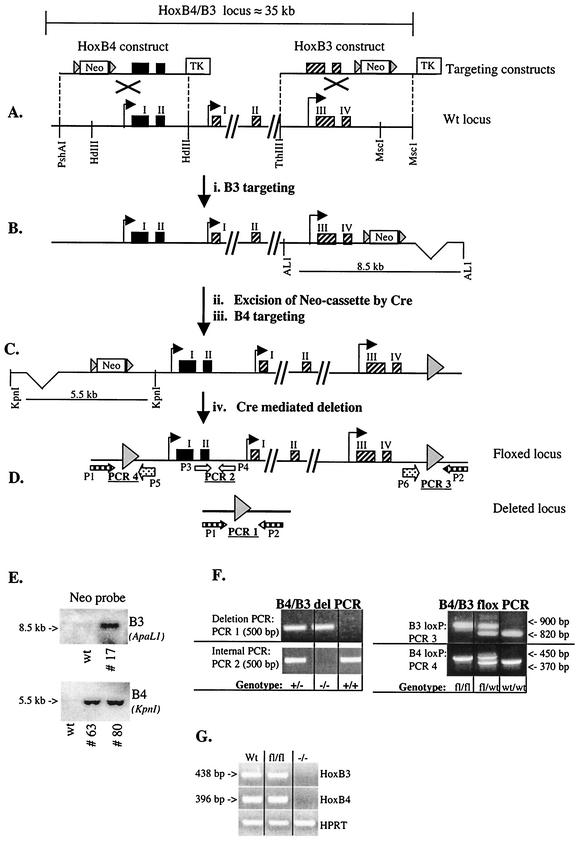FIG. 1.
Schematic overview of the Hoxb3/b4 locus and the targeting strategy. The gene targeting strategy successfully removes the Hoxb3 and Hoxb4 genes and generates mice without expression of Hoxb3 and Hoxb4 mRNA. (A) The Hoxb4 (exons shown as black boxes) and Hoxb3 (exons shown as hatched boxes) targeting constructs and the wild-type locus. The targeting constructs were generated by inserting a loxP flanked neomycin (Neo) cassette into the HindIII (HdIII) site upstream of Hoxb4 and in the MscI site downstream of Hoxb3. A thymidine kinase (TK) gene was included in the constructs for negative selection against random integration. Gray arrowheads depict loxP sites. (B) Recombinant allele after Hoxb3 targeting. To verify HR, Southern blot analysis with a 5′ external probe was performed, as well as a PCR strategy with one 3′ external and one 5′ internal primer (data not shown). (C) Recombinant allele after transient Cre expression, resulting in excision of the neomycin cassette and after the Hoxb4 targeting. HR was verified by PCR, with a 5′ external primer and a vector-specific primer within the floxed neomycin cassette (data not shown). (D) Recombinant allele after the second transient Cre expression. In the floxed version the Hoxb4 and Hoxb3 genes are flanked by loxP sites, but in the deleted version both of the genes have been excised by the Cre enzyme. (E) Southern blot analysis verifying single homologous integration of both Hoxb4 and Hoxb3 constructs separately, prior to Cre excision of the neomycin cassette. Genomic DNA was digested with ApaLI (AL1) or KpnI for screening of Hoxb3 and Hoxb4 targeting, respectively (see panels B and C) and probed with a neomycin-specific probe. Hoxb3 clone 17 was used for further targeting with the Hoxb4 construct, and the resulting independently doubly targeted clones 63 and 80 were used for experiments described in the text. (F) Examples of PCR results from genotyping of mice carrying the floxed (B4/B3-flox) or the deleted (B4/B3 del) version described in D. fl, floxed allele. (G) RT-PCR, verifying expression or lack thereof, of Hoxb3 and Hoxb4 in BM cells from a wild-type (Wt) mouse, a homozygous floxed mouse (fl/fl), and a knockout mouse (−/−). Hypoxanthine guanine phosphoribosyltransferase (HPRT) RT-PCR was done to verify presence of cDNA in all samples.

